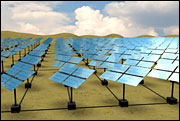
Energy wonk Robert McLeod has long post filled with statistics and graphs, arguing a simple point: if historical trends continue, solar power is going to dominate. Soon. (You’ll recognize this as substantially similar to the argument made by solar booster Travis Bradford.)
If you’re into statistics and graphs, read the whole thing. If not, here are some good excerpts:
Photovoltaic cells are not like any other method humanity uses to collect and use energy. Existing techniques extract energy either from mechanical motion (wind, hydroelectric, tidal) or heat differentials (fossil fuels, nuclear, solar-thermal). Whereas all these systems produce useful work by the turning of a shaft (usually to spin photovoltaics convert sunlight directly into direct-current electricity. While photovoltaics are still beholden to the laws of thermodynamics and entropy, the difference still implies that they abide by difference rules. In particular, they have a total absence of moving parts and as a result are almost free of maintenance requirements. Photovoltaic cells degrade in performance only very slowly as they are bombarded by cosmic rays. Most manufacturers offer warranties that guarantee they will still reach 80% of their rated power output after 25-years.
…
… solar production hasn’t been growing at 3.2% per year. It has, in fact, been growing at 33% per annum for the last decade [2], and it’s expected to continue that trend for the immediate future. … while the impact of solar may be trivial now, it will not be over the next 25 years. If solar can maintain the same growth rate is has for the past decade, solar can supply all of mankind’s projected electricity demands 26 years from now. [my emphasis]
…
The learning rate of photovoltaics is much higher than that of other energy technologies. In fact, it’s more in-line with things like computers or DVD players. … The small incremental nature of photovoltaics is a major advantage from a R&D perspective, as I’ve described previously. While coal and nuclear power plants are installed in increments of hundreds or thousands of megawatts, solar panels are measured in the hundreds of watts. Thus while a design change to a nuclear power plant can take a decade or more to manifest itself, solar manufacturers can do this in weeks. As a result, photovoltaic technology will go through hundreds of design revisions in the time it takes coal or nuclear plants to go through one.
…
Intermittency is the problem that renewable energy sources suffer from due to the natural fluctuations of their power source. Any transmission grid that relies on renewable sources as a primary input will require a substantial amount of storage, deferrable demand, or load-following spare capacity. The severity of intermittency can be thought of as a combination of its predictability, correlation to demand, and variance. Compared to its chief competitor, wind, solar is far more predictable. …
It is my opinion that the concern over intermittency of solar power is exaggerated. This is due to the fact that the learning rate of photovoltaics dictates that the cost of solar will fall below that of the main established sources of power (coal, nuclear) well before solar will constitute a significant fraction of our energy consumption. I think most people will agree, when the price of solar energy drops below that of the competition, the game changes. When you have power to burn, simple and low-capital techniques of storing or transmitting solar electricity become practical. At $0.05/kWh solar would have a margin of $0.04/kWh or more to work within for charging electric vehicles, filling deferrable demand, storage techniques such as Vanadium redox batteries, or long distance high-voltage direct-current transmission.
…
Many people will look at the graphs in disbelief that the easy path photovoltaic power has been traveling can continue. All I can really say in reply is, those are the historical numbers. The learning rate is exceptionally stable. The growth rate has been, if anything, accelerating in the face of a industry silicon shortage. Thin-film technologies seem well positioned to cause the price to continue to fail into the near future. Solar power doesn’t have very far to fall in many European nations before it’s cheaper than residential rates. As residential solar becomes the cheapest power available that will continue to push demand upward and fuel growth. There’s nothing obvious to me that says ‘Stop’ in solar’s future and it’s a fact of exponential growth that the early years matter the most. Even if the growth rate drops 1 % a year over the next 25-years the eventually outcome seems predetermined, it’s just a question of the timing.
(via WSJ)

